Once upon a time, in a land filled with dreams and wonder, existed a realm of magnificent palaces waiting to be discovered. Spain, the realm of enchantment, beckons you to step into a world where fairy tales come alive and make-believe becomes reality.
Embark with us on a wondrous journey, where the echoes of history whisper through time, and the grandeur of Spain's cultural heritage unfolds before your eyes. From fortresses perched atop ancient hills to palaces nestled amidst picturesque landscapes, each one tells a tale that will transport you to realms beyond imagination. Let's travel through Spain to unveil its most enchanting palaces.
The opulent Palacio Real de Madrid
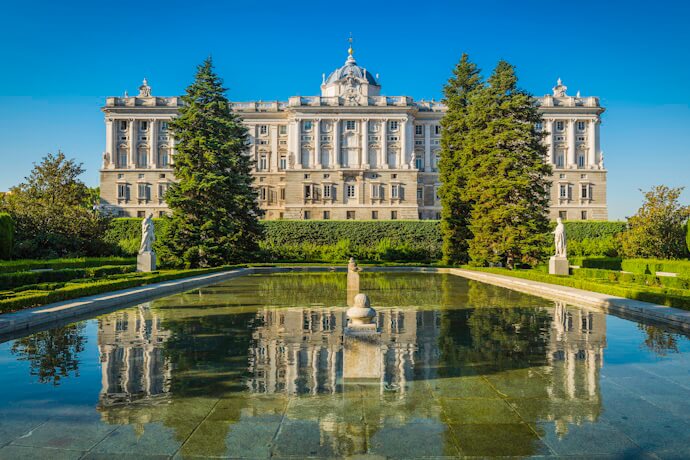
The Palacio Real de Madrid, also known as the Royal Palace of Madrid, is a majestic and iconic landmark that captures the essence of Spanish royalty and history. Located in the heart of the Spanish capital, this grand palace stands as a testament to the opulence and grandeur of a bygone era.
The construction of the Palacio Real began in 1738 and was designed in the Baroque style, with an imposing façade, intricate details, and magnificent proportions, which makes it a true architectural marvel. As one steps inside the palace, the interior showcases an eclectic mix of architectural styles, including Baroque and Neoclassical, reflecting the tastes and influences of various monarchs who occupied the palace throughout history.
One of the most breathtaking rooms in the Palacio Real is the Salón del Trono, or the Throne Room. This grand chamber features a golden ceiling adorned with frescoes, intricate chandeliers, and luxurious velvet draperies. It served as the setting for important ceremonies, royal audiences, and official events.
Nowadays, the Palacio Real is no longer the residence of the Spanish royal family (who lives in Palacio Real de Zarzuela), but it continues to be used for state ceremonies, official receptions, and as a venue for cultural events.
The breathtaking Palacio de Aranjuez
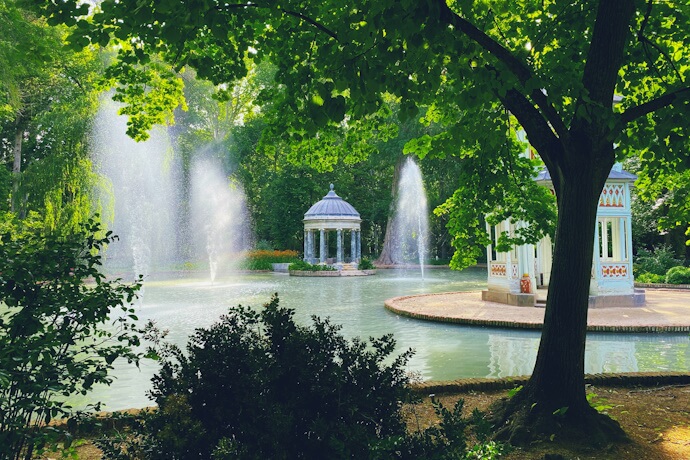
The Palacio de Aranjuez is a remarkable royal palace located in the town of Aranjuez, just 48 kilometres south of Madrid, with easy access by train. Its construction began in the 16th century, during the reign of King Philip II, and was designed as a royal residence and a retreat from the bustling city life of Madrid. The palace's façade is an impressive sight, characterized by its symmetrical layout and ornate decorations, giving an air of elegance and grandeur.
As visitors step inside, they are greeted by a series of lavish rooms and chambers, each meticulously decorated to reflect the tastes and styles of the era. The Royal Pharmacy and the Porcelain Room are some of the highlights of the palace, however, the gardens will take your breath away. Spread across a vast expanse of over 300 hectares, these are a stunning combination of formal and natural landscapes.
The Palacio de Aranjuez is not only a feast for the eyes but also a place of cultural significance. It has served as a royal residence, a hunting lodge, and a place for hosting important events and ceremonies throughout history. Today, the palace is open to the public, allowing visitors to explore its stunning interiors, stroll through its enchanting gardens, and gain insight into the rich history and artistic heritage of the Spanish monarchy.
The magnificent Palacio El Escorial
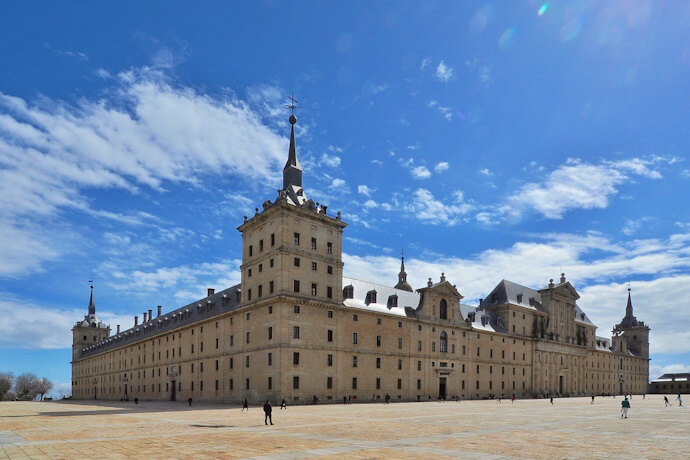
Palacio El Escorial, commonly known as the Royal Monastery of El Escorial, is an awe-inspiring architectural marvel located in the town of San Lorenzo de El Escorial, just 45 kilometres northwest of Madrid. This grand complex, considered one of the most important Renaissance buildings in Europe, serves as a symbol of Spain's cultural and historical heritage.
Commissioned by King Philip II of Spain in the 16th century, Palacio El Escorial was designed to be a royal palace, a monastery, a mausoleum for Spanish kings, and a centre of learning. The design of the complex was influenced by the Spanish Renaissance and the architectural principles of simplicity, harmony, and order. The symmetrical layout reflects a sense of balance and precision.
Upon entering the palace, visitors are greeted by a series of opulent rooms and chambers. One of the highlights is the stunning library, with floor-to-ceiling bookshelves, intricate woodwork, and magnificent ceiling frescoes – it is a treasure trove of knowledge and a testament to intellectual pursuits during the Spanish Golden Age.
Adjacent to the palace is the Basilica of the Monastery, a place of worship and spiritual reflection. The basilica's grand altar, adorned with gold leaf and intricate sculptures, creates a sense of reverence and grandeur. The Pantheon of the Kings, located beneath the basilica, serves as the final resting place for numerous Spanish monarchs, adding a solemn and regal atmosphere to the complex.
The lavish La Granja de San Ildefonso
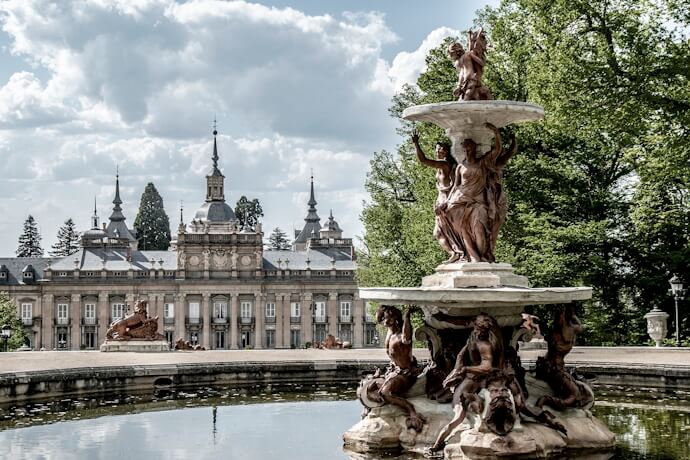
La Granja de San Ildefonso is a majestic royal palace and estate that enchants visitors with its grandeur, stunning gardens, and rich history. It is in the Segovia province, just an hour and a half drive from Madrid.
Built in the 18th century, this regal complex served as a summer retreat for the Spanish monarchy. Its centrepiece is the Palacio Real, or the Royal Palace, a Baroque treasure that showcases opulent interiors, intricate stucco work, and magnificent chandeliers. The Ballroom, with lavish decorations and massive mirrors, provides a glimpse into the extravagant celebrations that once took place within its walls.
However, it is the gardens that truly steal the show! Inspired by the famous gardens of Versailles, these are a masterpiece of landscaping and design. The Fountain of the Eight Seas, the centrepiece of the gardens, showcases a spectacular water display, with jets of water dancing in harmony to the delight of visitors. Beyond the Royal Gardens, the landscape surrounding La Granja boasts natural beauty and serene countryside, inviting visitors to explore the surrounding area and connect with nature.
Stepping into this world of regal elegance and natural beauty is possible, since the staggering building Casa de los Infantes, built in the 18th century by Carlos III for his sons, is now the Parador de La Granja. You can have your accommodation in this magnificent palace and appreciate the tranquillity and majestic atmosphere of this unique place.
The charming Palacio Real de Olite

The Palacio Real de Olite, or the Royal Palace of Olite, is located in the town of Olite, in the Navarre region of northern Spain. With its rich history, intricate design, and medieval charm, this palace transports visitors back in time to the splendour of the Kingdom of Navarre.
Originally built in the 13th century as a fortress, the Palacio Real de Olite was transformed into a royal residence. Its architecture showcases a blend of Gothic and Mudéjar styles, with influences from French châteaux and Spanish fortresses, and the irregular layout reflects its construction in various stages, as each addition fulfilled the evolving vision of its creators.
Standing tall and majestic the Palacio Real de Olite fascinates with its imposing silhouette. Exploring the palace's towers and battlements offers panoramic views of the surrounding countryside and the charming historic quarter of Olite. Nowadays, the Palacio Nuevo, or New Palace, is open for public visits and reflects the restoration after the War of Independence. The Palacio Viejo, or Old Palace, houses a Parador, offering the perfect opportunity to step into a fairytale of knights and princesses while sleeping in a mediaeval wonder.
The captivating Palacio de la Aljaferia

Not far from Olite, also in Northern Spain, the city of Zaragoza houses a mediaeval fortress-turned-palace that showcases a captivating blend of Islamic, Romanesque, and Mudéjar styles and reflects the diverse cultural influences that have shaped Spain over the centuries. It is the Palacio de la Ajaferia.
Originally built as a fortified palace by the Muslim rulers in the 11th century, this palace was later expanded and renovated by subsequent Christian monarchs. Approaching the fortress, visitors are immediately struck by its imposing walls, fortified towers, and sturdy defensive structures. The exterior boasts a mix of architectural elements, with Romanesque features blending seamlessly with intricate Islamic designs, showcasing the unique Mudéjar style that emerged from the cultural fusion of Muslim and Christian influences.
As visitors step inside, they are transported back in time to the opulent court of the Muslim rulers. The Throne Room, with its grand arches and ornate decorations, stands as a testament to the power and grandeur of that era. Visitors can explore a series of rooms, courtyards and gardens, namely the Patio de Santa Isabel, that unifies the entire palace. It is a journey through the complex tapestry of Spain's history, revealing the layers of cultural influences that have shaped the nation.
The sophisticated Palacio Magdalena

Upper North, overlooking the sparkling Bay of Santander, the Palacio de la Magdalena stands as a majestic beacon of elegance and charm. Nestled amidst lush gardens and embraced by the gentle Cantabrian Sea, this exquisite palace invites visitors to immerse themselves in a world of refined beauty and regal grandeur.
Built in the early 20th century, it was initially conceived as a royal summer retreat. Its architectural style effortlessly blends elements of English Tudor, French Renaissance, and Spanish regionalism, creating a captivating visual symphony that delights the senses.
From its striking towers and battlements to its elegant balconies and sweeping archways, the palace exudes an air of timeless sophistication. The lavish interiors showcase a harmonious fusion of ornate woodwork, intricate stained-glass windows, and sumptuous furnishings, transporting you to an era of aristocratic opulence.
Make sure to soak up all the panoramic vistas. The palace's privileged location provides breathtaking views of the Bay of Santander, with its azure waters stretching to the horizon. When the sunsets paint the sky in hues of pink and gold, it casts a warm glow over the palace and the surrounding landscape, leaving visitors spellbound by the sheer beauty of the scene.
The dazzling Palácio Episcopal de Astorga
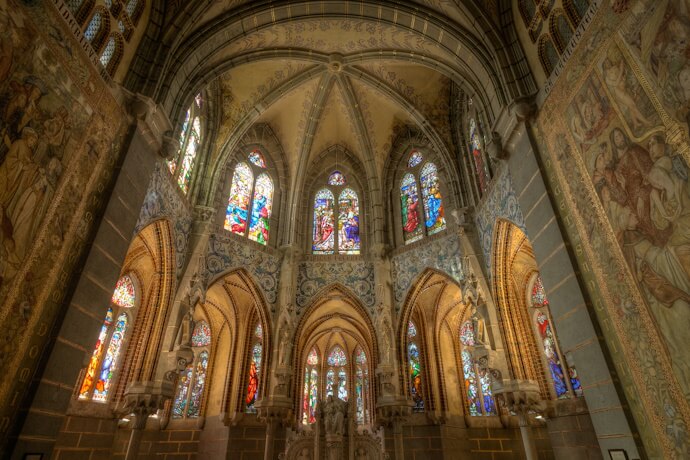
Heading west, we arrive at the charming town of Astorga, in the Spanish province of León, where the Palácio Episcopal de Astorga shows a harmonious blend of Gothic, Renaissance, and Baroque styles, testifying the creativity and vision of the renowned Spanish architect Antoni Gaudí.
Built between 1889 and 1913, the Episcopal Palace of Astorga was commissioned by Bishop Joan Baptista Grau i Vallespinós, who sought to create a residence befitting his position and showcasing the rich heritage of Astorga. Gaudí's distinctive architectural style, characterized by organic shapes, intricate details, and the imaginative use of materials, brought the palace to life in a truly captivating manner. Its signature motifs, such as the sinuous curves and nature-inspired elements, are delicately integrated throughout the palace, giving it an exquisite character.
Stepping inside the Palácio Episcopal de Astorga is akin to entering a realm of enchantment. The interior exudes a sense of elegance and sophistication, with its soaring ceilings, lavish ornamentation, and an abundance of natural light flooding through the expansive windows. Every room tells a story, with its unique designs and opulent details, reflecting Gaudí's meticulous attention to detail.
The picturesque Pazo de Oca

Further west to the luscious Galician countryside, only 25 kilometres from Santiago de Compostela, the Pazo de Oca emerges as a hidden gem, captivating visitors with its picturesque beauty and serene ambience. This elegant manor house, also known as the "Garden of the Galician Pazo," is a place where nature and architecture intertwine, creating a haven of tranquillity and timeless charm.
The origins of Pazo de Oca trace back to the 17th century when it was built as a noble residence of Dom Suero de Oca and consists of the palace, the chapel and the workers' houses. However, it is the surrounding gardens that elevate this manor house to an ethereal realm of natural splendour.
The gardens of Pazo de Oca are a symphony of colour, fragrance, and meticulously arranged landscapes, inviting visitors to immerse themselves in a world of unparalleled beauty. Meandering paths lead to hidden corners, where vibrant flowerbeds burst with a kaleidoscope of blooms, filling the air with their sweet fragrance. Within the gardens, architectural elements punctuate the natural landscape, enhancing its beauty. The romantic stone bridges, elegant gazebos, and ornate benches offer picturesque spots to pause and soak in the serene atmosphere.
The Pazo de Oca gardens have been lovingly maintained throughout the centuries, preserving their timeless allure. It is a place of passage for the Pilgrims of the Camino de Santiago, by the “Camino de Inverno” and “Vía de la Plata”. The passage of time has only added to their charm, as ancient trees stand as witnesses to the stories and memories woven into the fabric of this alluring place.
The stunning Alhambra
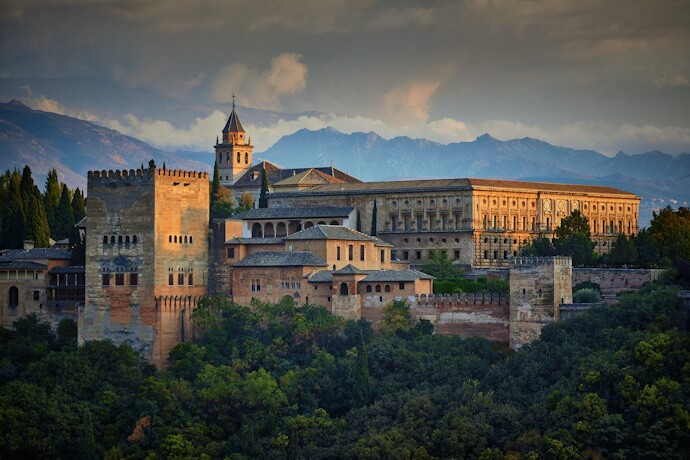
And now it is time to head south and introduce you to the magnificent Alhambra! This is the most visited monument in Spain and one of the most visited in the world - and it has good reasons for it!
Perched atop a hill overlooking the city of Granada, in the Andalusian region, this UNESCO World Heritage Site, with its intricate Islamic architecture, lush gardens, and captivating views, stands as a symbol of the Moorish legacy in Spain. Its name, La Alhambra means "the red fortress" in Arabic, and is derived from the reddish hue of its walls which glow in the light of the setting sun, adding to its ethereal beauty.
Dating back to the 9th century, the Alhambra underwent significant expansions and renovations in the 13th and 14th centuries. It became the residence of the Muslim rulers of the Emirate of Granada, serving as a palatial city within a city. The complex consists of several palaces, courtyards, gardens, and defensive structures, each with its own unique charm.
The Nasrid Palaces, the heart of the complex, are a masterpiece of Islamic art and design. Intricately carved stucco, ceramic tiles, and exquisite filigree work adorn the walls, while delicate archways and latticed windows create a play of light and shadow, enhancing the ethereal ambience of the space.
The Alhambra is not merely an architectural marvel but also a repository of history, culture, and artistic expression. One can marvel at the ingenuity of Islamic architecture and immerse themselves in the tranquillity of its gardens, but the true treasure of the Alhambra is the cultural fusion that shaped Andalusia.
Let’s travel to a place where fairytales never fade!
Spain, a land of wonder, where each palace has a story to tell—a tale of opulence and ancient heritage. In every step you take, you will be transported to a world of timeless charm and majestic allure that lingers in the air. With their rich history and architectural splendour, these Spanish palaces are like gateways to a bygone era, born from the imagination of ancient artisans, reflecting the pride and reverence that Spain holds for its diverse cultural influences. Imagine yourself living a royal affair over Spain's palaces, where history and fantasy intertwine... just pack your bags and be swept away by the charm and allure that awaits you!



